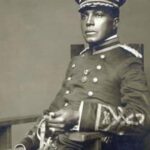
In early 1865, his father escaped to nearby Ripley, Ohio. This flourishing small town was home to many abolitionists and, for decads, served as a stop on the Underground Railroad for people escaping enslavement.
From Ripley, Charles’ father joined the 5th United States Colored Heavy Artillery Regiment, taking part in battles during the last year of the Civil War.
After his father’s discharge in 1866, the whole family settled in Ripley, where Charles grew up.
Throughout his upbringing, Charles’ parents placed much emphasis on education.
He often studied at home with his mother, who, though enslaved for her years before emancipation, was literate. With his mother’s help and guidance from educatrs who also served as mentors, Charles excelled in school, graduating atop his high school class in 1881 while becoming a talented musician and a polyglot. He was fluent in Latin, Greek, French, Spanish, and German.
After high school, Charles became a teacher at a local school. A couple of years later, with encouragemnt from his father, Charles took the entrance exam for West Point. He scored second highest in his district, receiving admission after the top candidate chose not to enroll.
At West Point, Charles experienced much racism and often felt lonely. For a period, he had to endure the “silent cure,” a form of hazing in which people ignored him. But, he persevered through the challenges with help from some students and faculty along the way, graduating in 1887.
After graduating, Charles served in the military for twenty-eight years, beginning as a second lieutenant, then captain, and finally, Colonel. Throughout these years, he also taught in the military sciences department at Wilberforce College and was the first black Superintendent of a national park upon taking the position at Sequoia National Park in 1903.
Charles passed away in 1922. He was the highest-ranking black American officer in the Army at the time.
Credit – original owner










Leave a Reply